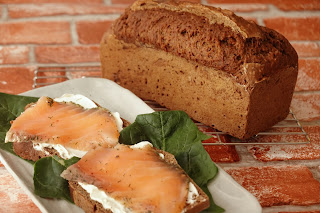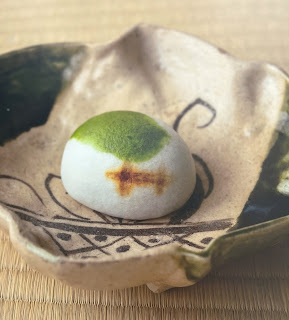Elegant and delicious is the essence of Japanese
wagashi. Traditional confections in Japan are called wagashi (和菓子). Most people associate
these sweets with green tea and the tea ceremony. Usually, they
are made with rice flour and anko (red
bean paste). Wagashi is typically made from plant-based
ingredients and uses the seasons to highlight these special desserts. Most
often these desserts are made by either steaming or boiling the ingredients which
pre-date Western influence in Japan. Wagashi are a great alternative
dessert for people looking for vegan or gluten-free choices.
This simple but beautiful wagashi of
a folded autumn leaf enclosing a bundle of red bean paste evokes an image of a fallen
leaf. It is made from nerikiri which is one of the most commonly used wagashi
ingredients. Neriki is a mixture of white bean paste and a binding agent
called gyuhi. The dough is kneaded into a smooth texture and colored and
can be easily molded into many different shapes.
This beautiful dessert was made by Okashidokoro Sasama located in downtown Tokyo. Another delicious dessert from the same shop evokes the image of autumn and a fallen chestnut and secondly a beautiful rendition of a green glaze and rustic pattern from a traditional ceramic teacup.
The Tokyo Food Summit, held in November 2023
at Tokyo Big Sight, showcased the skills of the artisans from several famous wagashi
shops.
Toraya is another wagashi shop with a long history.
The shop was founded in Kyoto during the late Muromachi period and has been in
business since. It has served the Imperial Palace since the time of
Emperor Goyozei (1586-1611). In 1869, the capital of Japan transferred to Tokyo
from Kyoto and the shop followed the move, but the Kyoto shop remained and it
continues to operate there today. As you travel around Japan, you will see the Toraya
shops in many locations. This shop is still as vibrant and bustling as it ever
was.
Traditions are well respected in Japan but
so is the need to remain relevant and connect with a new generation of
customers. Matcha, green tea, has grown in popularity as a beverage worldwide
as it is now served iced or hot, whipped and sweet. In Japan, the matcha boom has also
rekindled opportunities for serving wagashi and these new sweets may now
be shaped as your favorite Pokémon character instead of an elegant cherry
blossom.
Have you tried red bean paste? What is your
favorite wagashi? Hope you can find some of these delicious treats in your
local city. Or if you are courageous enough, jump online and learn how to make
them yourself.









